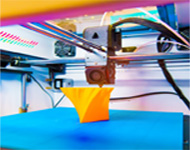 Plastic is one of the most commonly used materials for 3D printing nowadays. However, plastic 3D printing has its own limitations such as high amount of wastage.
Plastic is one of the most commonly used materials for 3D printing nowadays. However, plastic 3D printing has its own limitations such as high amount of wastage.
When it comes to 3D printing, quality and printing processes are now improving. Thus, engineers and designers are now able to find an alternative to increase 3D parts production. Many engineers and designers are now using metals as substitute for plastic. Still, metals materials have also its own strengths and weaknesses when it comes to 3D printing.
To help you choose which one is appropriate for your 3d printing project, here is a blog post about the differences between plastic 3d printing and metal 3D printing.
Overview: Plastic vs Metal
FDM technology is known for using plastic materials in 3D printing. Some of these plastic materials are in the form of filament spool. One of the most commonly used filament is ABS. It is a thermoplastic that contains a base of elastomers. Other types of plastic include PLA, ASA, PET and Polycarbonate.
On the contrary, SLS or Selective Laser Sintering is known using metal materials. 3D printing with metals offers an unique combination of practical and aesthetic properties.
Most engineers and designers choose metals to suit a variety of product requirements. Metal alloys such as aluminium, stainless steel, titanium and cobalt chrome are commonly used for metal 3D printing.
Below is a closer look at the differences between plastic 3D printing and metal 3D printing.
Build time and complexity
Plastic 3D printing has generally shorter build time than metal 3D printing. Plastic 3D printers also utilise less energy and the parts can be done in thicker layers.
Since 3D printers that use metal materials requires a high level of sophistication, the printing process can be time-consuming. Plastic also needs sophistication when it comes to making the desired 3D part. However, it is not the same level of scrutiny compared to metal.
Cost
Most 3D plastic printers are fairly inexpensive. Aside from that, most of these 3D printing machines are easy to use. Plastic filaments such as ABS are also cheap.
When it comes to machine cost and cost per build hour, metals are more expensive than plastics. 3D printers and materials for metals are also costly.
Easy to use
Plastic 3D printing is now the material of choice for most beginners since it easy to use. Plastic materials are also readily available in low quantities.
Metals 3D printing, on the other hand, are normaly not user-friendly. Unlike plastic 3D printing, metal 3D printing requires to be fed, melted and solidified while maintaining its material properties.
Printing process
FDM, SLA and SLS are some of the 3D printing processes for plastic 3D printing. These technologies use different varieties of plastic.
Engineer and designers nowadays can choose between different 3D printing processes for metals. Each of them uses different systems. There are powder-bed systems like SLM and DMLS. There are also powder-fed systems such as DED (directed energy deposition) and LMD (laser metal deposition).
Availability of materials
Plastic material is one of the most used materials in the 3D printing industry. Thus, it is readily available compared to metal. Plastic is also way cheaper than metal material. This is another reason why plastic is known to be the choice for most beginners.
Aside from that, plastic has a wide variety of choices for 3D printing. However, metal materials are still limited to aluminium, stainless steel, titanium and cobalt.
Post-processing/finishing procedures
Post-processing for 3D printing with plastic can be done easily. The designer can accomplish the desired outlook and texture of the object by hand or simply use tools.
For metal 3D printing, post-processing is required to improve the mechanical properties and appearance of the object. However, post-processing for metals is more labour intensive and expensive.
Other processing parameters
Temperature and power requirements
Plastic has lower melting point comparing to metals. As a result, temperature and power requirements in plastic 3D printing is lower than metal 3D printing.
Material properties
Since metal must meet casting and forging standards, it has much higher material properties than plastic properties.
Conclusion
Additive manufacturing for both plastic and metal are now introduced to make production of 3D parts easier and faster. There are still some limitations for this two 3d printing methods but the technologies that were used for both materials have been improving.
Product engineers and designers should clearly understand the difference between plastic 3D printing and metal 3D printing. This is to choose the appropriate material for a specific 3D printing project.
Partnering up with a 3D printing service provider for your project can help you achieve reliable results. They can design mechanical design and drafting, custom 3D printing parts and many more.








